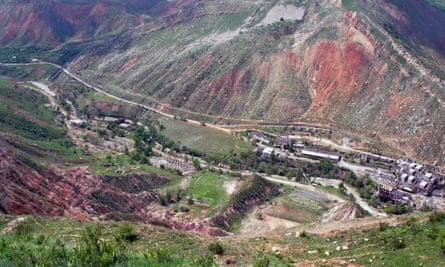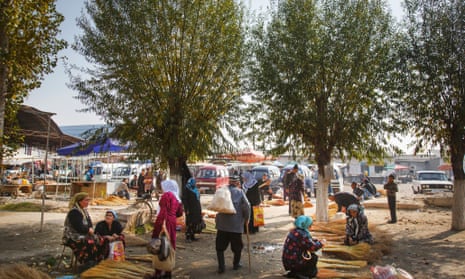On the ground floor of Mailuu-Suu’s central hospital, pharmacist Ainagul Parpibaeva says she’s had enough.
“We’re full of illness. Many people have cancer, leukaemia. I think this is because of the uranium, but the government never tells us anything,” she says. People continuously come to her complaining of the same symptoms over and over, “like children who are nauseous and vomit”, she explains.
Almost everyone in this mining town in southern Kyrgyzstan can recount tales of recent deaths amongst family and friends, often related to cancer. But despite being consistently rated one of the world’s most polluted places thanks to nearby Soviet-era radioactive waste dumps, cleanup measures have been limited.
The town was once closed to outsiders, with workers getting handsome salaries to perform dangerous work. They produced 10,000 metric tonnes of radioactive uranium between 1946 and 1967, providing much of the fuel for the Soviet Union’s first nuclear weapons and atomic energy plants.
But they also buried millions of tonnes of waste from the milling of the radioactive metal along the river that runs through it. At the time, the wellbeing of workers was not a priority and little thought was given to future health hazards.
However, since the collapse of the Soviet Union in 1991, locals say there has been little monitoring or maintenance of the dumps: “Production targets usually took precedent over environmental, health and safety standards,” the International Atomic Energy Agency wrote in a 2010 report, which warned that Mailuu-Suu was in urgent need of a cleanup.
The anti-pollution thinktank Blacksmith Institute still reports high cancer rates and poor immune systems among adolescents.
Confusion
The town is one of seven sites across Kyrgyzstan with radioactive waste dumps containing tailings – a byproduct from milling uranium ore. Overall, government figures indicate the country is home to 92 hazardous dumps containing 475m tonnes of waste, with a quarter of these near Mailuu-Suu. Radiation and hazardous radon gas – produced as uranium decays – are big concerns for inhabitants and health agencies, as are the carcinogenic heavy metals that have seeped into the water supply.
“Some of the protective dams [surrounding the waste] built by the Soviets are in very bad condition,” says Damir Kushbakov, the top official for tailings at Kyrgyzstan’s ministry of emergency situations.
His modest budget funds only the most urgent repairs to dams that are slipping into the river, and he says his office spends much of its money refilling holes where locals have scavenged for metal.
Standing on an unmarked tailings dump (the fence surrounding it was looted long ago), Kanybek Kydyrov, who also works at the ministry of emergency situations, says uranium is leaking into the river a few feet away. Behind him, a shepherd leads his goats across the radioactive pile. A few kilometres downstream, boys fish with nets.
Though officials insist they organise education campaigns and teach children to stay away from the toxic sites, few locals seem aware of the invisible threat. “Even in the hospital they don’t give you information or tell you not to go there [to the dumps] or about related health problems,” says Chinara Sarieva, a 35-year-old cradling a baby at her home in the town.
A girl of 12 is surprised when asked if her teachers have ever warned of the tailings: “No, why?”
Local health workers are often uneasy discussing the risks. Though there are significant links between cadmium, a heavy metal present in Mailuu-Suu’s water, and increased risk of uterine cancer, one doctor claimed the high frequency of cases in Mailuu-Suu is because local women have “too little sex”.
The deputy director of the city’s main hospital, Okumzhan Maksutaliev, confirms he has seen a rise in cancers in recent years, but insists there is nothing special about Mailuu-Suu. “There are increasing cases of cancer all over the world,” he claims.

Costly cleanup
In December 2013 the United Nations general assembly called on the international community to assist Central Asian states with a region-wide clean up of toxic sites, but local officials complain progress is slow.
Conspiracy theories circulated amongst the local population are catalysed by a lack of information, combined with pervasive concerns about corruption among a population accustomed to receiving little support from the state. “People say that the authorities get extra payments for the dangers [we’re exposed to] and that we should get this too, but we don’t, so they probably just put it in their pockets,” says Parpibaeva, the pharmacist.
Ira Sarieva, 58, who sells women’s clothing to support her pension, echoed such suspicions, voicing a belief that officials have taken foreign assistance money earmarked for the cleanup.
Despite widespread distrust, both officials and donors consider one pilot project a success. Between 2010 and 2012, a World Bank-led venture moved one of the most precarious of Mailuu-Suu’s 23 tailings dumps to safer ground and reburied it, at a cost of $8.4m (£5.3m). Moving the remaining highest-risk tailings in town would cost a further $50m, the ministry of emergency situations estimates.
Some locals are opposed to the moves, motivated, in part, by lack of information. Jumakan Bekbaeva, a 63-year-old widow who cares for most of her nine grandchildren, says her granddaughter became sick with thrombocytopenia – a shortage of blood platelets – shortly after the World Bank project ended.
“It was because of the uranium, because they uncovered the tailings,” says Bekbaeva. “Everyone here associates any death with the mining. After the tailings were opened [to move them], many people died. People believe this, but our doctors won’t admit it.”
A version of this article originally appeared on EurasiaNet

Comments (…)
Sign in or create your Guardian account to join the discussion